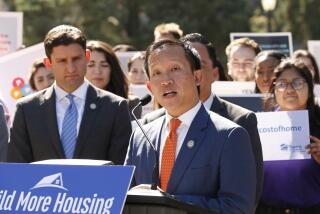Trump threatens to dump immigrants into California’s ‘sanctuary cities’

- Share via
Reporting from WASHINGTON — President Trump taunted California on Friday with an attention-grabbing threat to dump detained migrants into the state’s “sanctuary cities,” despite warnings from his advisors that such action would run afoul of the law.
The presidential rhetoric seemed geared toward provocation, and it was unclear how seriously he intended it. Trump has made previous threats against the state, including one to withhold disaster relief money after devastating wildfires, without ultimately following through.
Trump both tweeted and spoke about the proposal after the Washington Post published a story on Thursday revealing that the idea had been discussed several times in recent months. Administration officials told the newspaper that the idea had been “floated and rejected,” but Trump undercut their denials on Friday, insisting he was still giving the idea “strong consideration.”
The plan would call for busing migrants from detention centers near the border and releasing them into the districts of Democratic lawmakers and other opponents of Trump’s immigration policies.
Though many other states have sanctuary counties and cities, Trump has repeatedly singled out California for criticism.
“California certainly is always saying, ‘Oh, we want more people,’ ” Trump told reporters during an unrelated White House event Friday. “And they want more people in their sanctuary cities. Well, we’ll give them more people. We can give them a lot. We can give them an unlimited supply. Let’s see if they’re so happy.
“They’re always saying they have open arms. Let’s see if they have open arms,” he continued.
Trump repeated his complaints about Democrats’ unwillingness to change asylum laws and his contention that gang members and others with criminal records were abusing the system.
He also claimed that smugglers had left Texas ranches along the border littered with bodies after abandoning the migrants with nothing more than a sandwich, a soda and vague directions to Houston. Although smugglers have been known to abandon people after getting them across the border, it was unclear what Trump was referring to.
He also took the opportunity to criticize sanctuary jurisdictions, including the state of California, which resist certain forms of cooperation with immigration authorities.
House Speaker Nancy Pelosi (D-San Francisco) told reporters during the House Democratic Caucus retreat in Leesburg, Va., that she knew nothing about the plan.
“It’s just another notion that is unworthy of the presidency of the United States and disrespectful of the challenges that we face as a country, as a people, to address who we are, a nation of immigrants,” she said.
California Gov. Gavin Newsom said of Trump’s idea: “It is illegal. It is immoral. It is unethical. It is sophomoric. It is petulant. And it is par for the course.”
Rep. Bennie G. Thompson, the Mississippi Democrat who leads the House Committee on Homeland Security, said even the suggestion of sending detainees to sanctuary cities is “a reminder that the Trump administration’s reckless immigration agenda is not about keeping the country safe, but about partisan politics and wantonly inflicting cruelty.”
The Post reported that the idea was spearheaded by Stephen Miller, a White House advisor who has been the architect of some of Trump’s most provocative immigration proposals, including his ban on travel from several Muslim-majority countries. Miller had also urged Trump to embrace a child separation policy that was officially overturned in June, after two tumultuous months, but never completely ended.
After repeated suggestions by Miller, Homeland Security officials sought a formal legal opinion which said that the plan would be inappropriate and not in accordance with federal law.
When people cross the border and say they are seeking asylum in the U.S., the government can detain them until their hearing before an immigration judge. Because the number of immigration judges hasn’t kept pace with the sharp increase in asylum applications, the wait for a hearing now routinely takes more than a year.
Because the government lacks enough space to detain all the people waiting for hearings — and because court orders limit how long officials can detain children — some detainees are given a court date and released, a practice that Trump has railed against. Those who have records of violence or criminal activity typically are not released.
It’s not clear what legal authority, if any, the government would have to transport detainees a long distance before releasing them.
Sanctuary cities have long been a favorite target for Trump. During his campaign, he repeatedly criticized San Francisco for releasing from custody an immigrant who later fired a shot that killed 32-year-old Kathryn Steinle in 2015. The immigrant was ultimately acquitted in the shooting after defense attorneys argued the shot had been fired by accident. Trump called the acquittal a “disgrace.”
The administration has tried to cut off some federal money to sanctuary cities, but at least seven different federal courts have ruled those efforts unlawful.
Miller, who was raised in Santa Monica, has encouraged Trump’s recent threats to close the border with Mexico, which the president backed down from last week. Trump also promised before the November congressional election that he would sign an executive order ending the constitutional right to citizenship for people born on American soil. But he did not follow through with that either.
Still, he has followed through on other unlikely threats, including the one that resulted in a 35-day government shutdown that began in December after Congress refused to spend $5.7 billion on a border wall. Despite warnings from some congressional Republicans, Trump in February declared a federal emergency at the border to access money for the wall that Congress had denied.
Times staff writers Jennifer Haberkorn in Washington and John Myers in Sacramento contributed to this report.
More to Read
Get the L.A. Times Politics newsletter
Deeply reported insights into legislation, politics and policy from Sacramento, Washington and beyond. In your inbox twice per week.
You may occasionally receive promotional content from the Los Angeles Times.











